Carl Zeiss Asiola
| Das Asiola mit einem Porro-II-Prismensystem wurde zuerst in den 30er Jahren von Zeiss Jena hergestellt. In den Jahren der VEB Carl Zeiss Jena (DDR) wurde es als "Monokulares Aussichtsfernrohr 63/420" angeboten. Somit hatte sich der Objektivlinsendurchmesser auf 63mm erhöht. Das Objektiv war ein Luftspaltachromat mit 3 silbernen Distanzplättchen. Die Okulare waren austauschbar, so dass Vergrößerungen von 17x, 26x oder 42x erreichbar waren. Sie wurden in eine Fassungshülse gesteckt, die sich zum Fokussieren drehen ließ. Die Optik war natürlich vergütet (blau). | The Asiola having a porro II prism system was first made in the 1930s by Zeiss Jena. During the production years of VEB Carl Zeiss Jena (GDR) it was offered as a "Monocular Look-out Telescope 63/420". So, the objective diameter increased to 63mm. The objective was an air-space achromatic lens with three silvery spacer plates. The eyepieces could be changed achieving magnifications of 17x, 26x and 42x. They slipped into the eyepiece tube which could be rotated for focusing. The optics were coated blue, of course. |
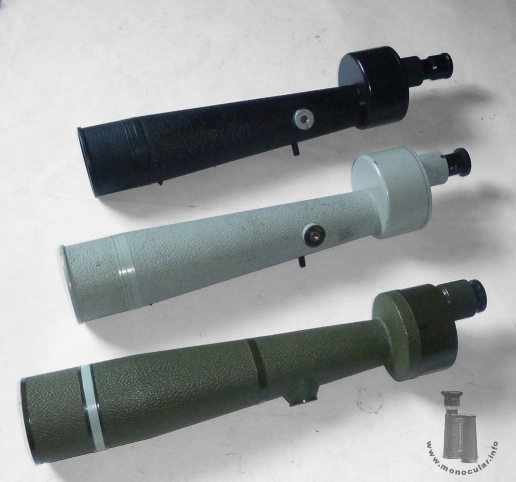
| Im Laufe der Jahre wurde die Farbgebung von schwarz über grün nach grau geändert. Es liegen auch grüne Modelle vor, die von dem zumeist gebräuchlichem Design abweichen. Dies bestand aus der genannten Okularkonstruktion, einem runden Prismengehäuse mit 3fach angeschraubtem oberen Deckel und einer glatten lackierten Oberfläche - auch der Dekorationszwischenringe - sowie einem konischen Objektivtubus mit strukturierter Farbummantelung, einem Kimme-und-Korn Visier und einem angeschraubtem Stativgewinde, auf dem zumeist die Seriennummer eingeschlagen war. An dem Standardgewinde konnte ein Stativadapter geschraubt werden, der eine Aufnahme zum Aufstecken und Festschrauben auf den Dorn des Holzstatives hatte. Das Asiola wurde mit einem weichen Ziegenlederfutteral geliefert. Das Objektiv war ca. 4cm nach innen zurückversetzt, so dass der Tubus einen Blendschutz ergab. | Through the years the coloured finish was altered from black over green to grey. There are also green models which differ from the most common design. This design comprised the eyepiece construction as mentioned above, a round prism housing with a top cover plate having three screws and a painted smooth surface (also applies to the decoration rings) as well as a conical objective tube with a textured covering, a notch and bead sight plus a screwed on thread tripod mount. The latter was usually stamped with the serial number. It could also be attached to a tripod adapter which clamped onto the tripod rod. The Asiola was issued with a soft goat leather case. The objective lens was retracted by abut 4cm thus forming a ray-shade. |
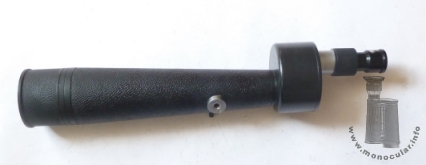
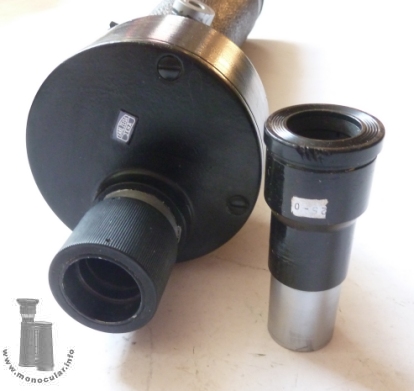
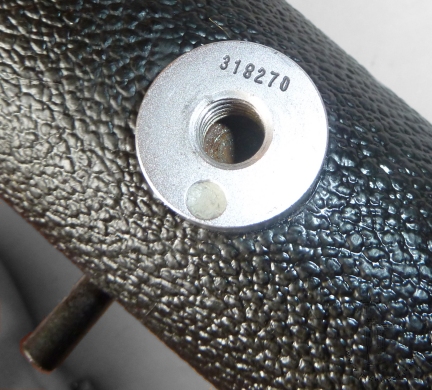
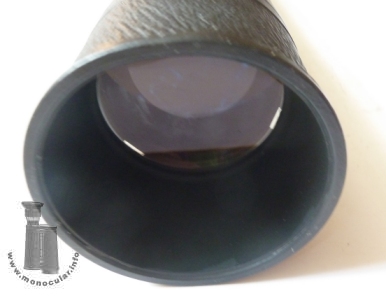
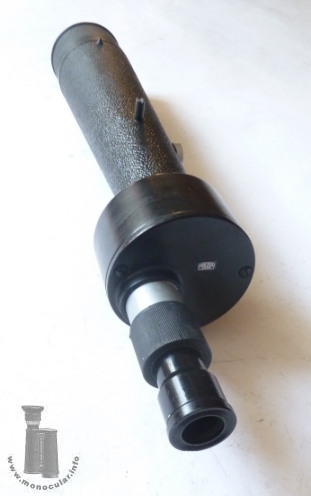
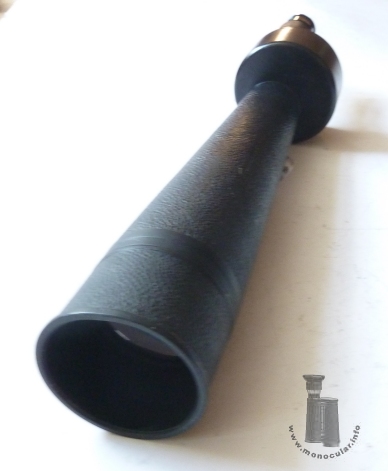
| Das schwarz lackierte Modell weist diese Baumerkmale auf. So auch eine grüne Variante (eher selten) und die grauen Modelle. Alle haben am 3fach verschraubten oberen Deckel angeschraubte oder aufgeklebte Typenschilder, wobei es bei diesen zahlreiche Beschriftungsvarianten gibt inklusiver solcher mit "Jena", "aus Jena" Kennzeichnung für Exportmodelle. Oft ist es mit dem "1Q"-Qualitätszeichen beschriftet. | The black painted model came with these design features. A green rarer model and the grey model also followed that design. All models came with model labels screwed or glued onto the top cover, which had three screws. There were a vast variety of labels or markings respectively including those for export models marked with "Jena" or "aus Jena". It often was marked with the "1Q" quality sign. |
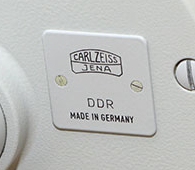
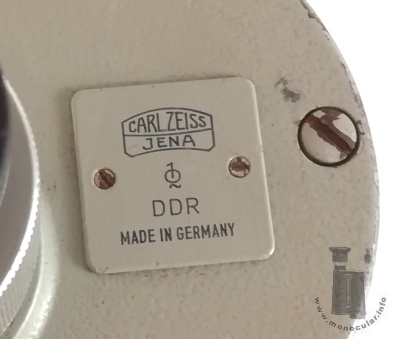
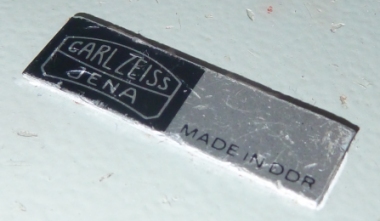
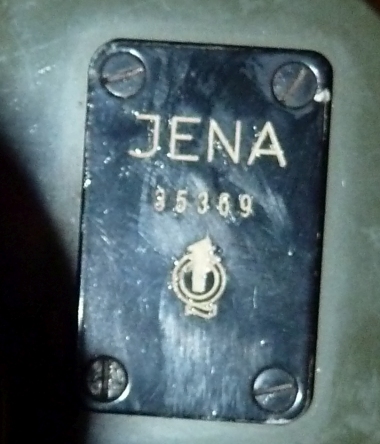
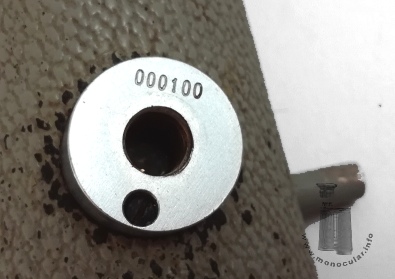
| Das olivgrüne Modell mit der Seriennummer 21294 hat ein Okular mit f=10mm, was eine 42er Vergrößerung ergibt. Abweichend zu dem Standarddesign hat es kein Visier, das Stativgewinde ist in einem konischem Stumpf eingegossen und das runde Prismengehäuse hat einen unteren Teil mit strukturierter Oberfläche, auf dem die glatte Prismendose geschraubt ist. Auf deren oberen Seite sind das Zeiss-Linsenlogo und die Seriennummer mit vorangestellter "Nr."-Abkürzung eingraviert. Der Zwischenring am Objektiv ist farblich grau abgesetzt. Im Zeiss-Archiv wird diese Variante um 1954 datiert (ZA Ident.-nr. 8901). Eine andere grüne Variante hat dieselbe Prismengehäusekonstruktion, aber einen glatten breiteren Ringschelle, an dem das Stativgewinde gegossen ist. An der Ringschelle befindet sich oben die Kimme und am Tubus das Korn. Die Beschriftungsplatte lautet "Jena 35369 1Q". Diese Variante wird im Zeiss Archiv (Ident.nr. 8922) auf 1958 datiert. Das Nachfolgemodell (Ident.nr. 8402) wird für 1968 angegeben, ist aber mit dem gleichen Design abgebildet. | The olive green model with serial number 21294 has a ocular f=10, achieving a 42 times magnification. Contrary to the standard design it has no notch and bead sight, the tripod thread is cast into a conical mount, and the round prism box has a lower part with a textured paint. The top part of the prism box is screwed onto this lower part again. On its top cover it is marked with the Zeiss lens logo and a serial number preceded by the "nR." abbreviation. The decoration ring is grey contrasting to the other colour. The Zeiss Archive lists this variant dating from about 1954 (ZA Ident.-nr. 8901). Another green variant comes with the same design of the prism housing, but with a broader smooth clamp ring to which the tripod thread is cast. The notch is attached on the top of the clamp and the bead is on the top of the conical tube. The label says "Jena 35369 1Q". This model is listed in the Zeiss Archive (Ident.nr. 8922) dating from 1958. The successing model (Ident.nr. 8402) is dated 1968, but is pictured with the same design in the Archive. |
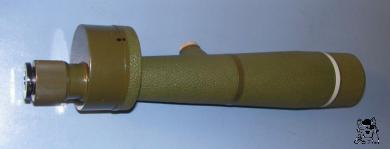
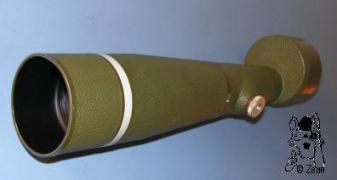
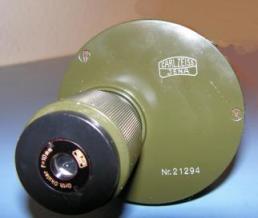
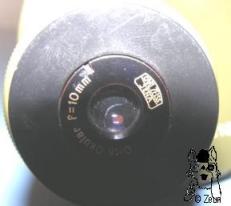
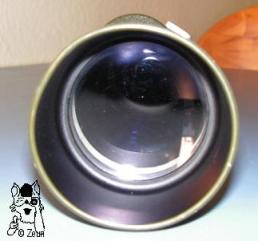
| Die Seriennummern wechseln von sechsstelligen bei den schwarzen zu fünfstelligen bei den grünen zu wiederum sechstelligen Nummern bei den grauen Modellen, so dass eine zeitliche Reihenfolge derzeit noch nicht klar definierbar ist und die Modellvarianten ggf. ihre eigenen "Nummernkreise" haben. Möglich ist eine Abfolge von schwarzem Standardmodell (Anfang der 1950er) über 1. und 2. grüner Variante (1954-1960er) zurück zur grünen und dann anschließend grauen Standardkonstruktion. Die niedrige Seiennummern mit drei voranstehenden Nullen bei einer grauen Version, könnte ien sehr frühes graues Modell kennzeichnen. Letztere grauen Modelle wurden bis ca. 1989 als Zeiss diese mit den (blauen) Aspectem-Modellen ablöste. | The serial numbers change from 6 digit numbers on the black models to 5 digit numbers on the green models, and back to 6 digit numbers on the grey models. Thus a clear succession of serial numbers is uncertain, but maybe every model had its own "number circle". A possible succession may be: black model (beginning of the 1950s), 1st and 2nd green model variants (1954-1960s), the green standard design and finally the grey model. The low sserial numbes with three leading zeros "000100" on one grey version may designate an early grey model. The grey model then was produced until about 1989 when Zeiss issued its new successing model "Aspectem" with a blue painted covering. |
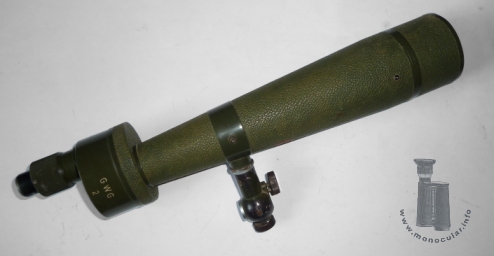
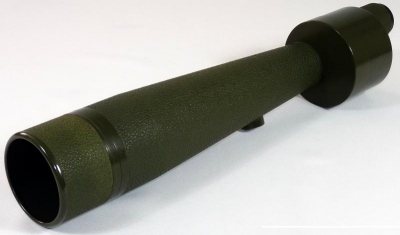
| Das Asiola wiegt nicht ganz 1,5kg. Die blau vergütete Objektivlinse misst 63mm, während der Objektivtubus bei der grünen Variante 77mm, beim grauen 80mm am Ende ist. Am Ansatz erreicht er einen Durchmesser von 48mm bzw. 50mm. Das dosenförmige Prismengehäuse ist 85mm (grün) bzw. 95mm (grau) im Durchmesser und 51mmm hoch. Das Okularstück ist 39mm im Durchmesser und 5cm hoch. Am eingesetzten Okularlinsensystem ist eine flache Plastikaugenmuschel aufgeschraubt. Die Gesamtlänge variiert zwischen 33,5 und 35,3cm. Das Spektiv hat eine olivgrüne oder graue Lackierung am strukturierten Gehäuse. Die beiden Modelle variieren in einigen Baudetails. |
The Asiola weighs almost 1.5 kilos. The blue coated objective lens measures 63mm in diameter, whereas the objective tube of the green model is 77mm, of the grey model is 80mm at its end. At its other end it is 48mm or 50mm in diameter. The can-shaped prism housing is 85mm (green) and 95mm (grey) in diameter and 51mm tall. The eyepiece is 39mm wide and 5cm tall. There is a plastic eye-cup ring screwed onto the ocular lens system. The overall length varies between 33.5 and 35.3cm. The spotting scope has an olive green or a grey painting at its textured body surface. The two GDR models vary in some construction details, |
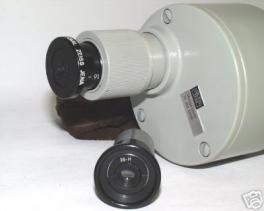
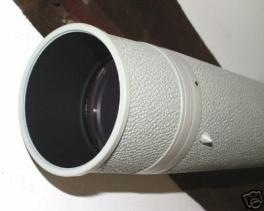
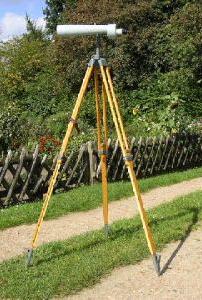
| Weitere Infos zum Asiola unter: Meridiankreis (alte Seite). "Docter" (Jena Analytik) als Nachfolgefirma von Zeiss Jena bringt heutzutage das Aussichtsfernrohr "Aspectem" als Weiterführung heraus, allerdings mit Porro 1-Prismensystem. | Further information see: Meridiankreis (old website). "Docter" (Jena Analytik) successor to Zeiss Jena issues a Aussichtsfernrohr "Aspectem" as today's follower, although it has a Porro 1 prism system. |
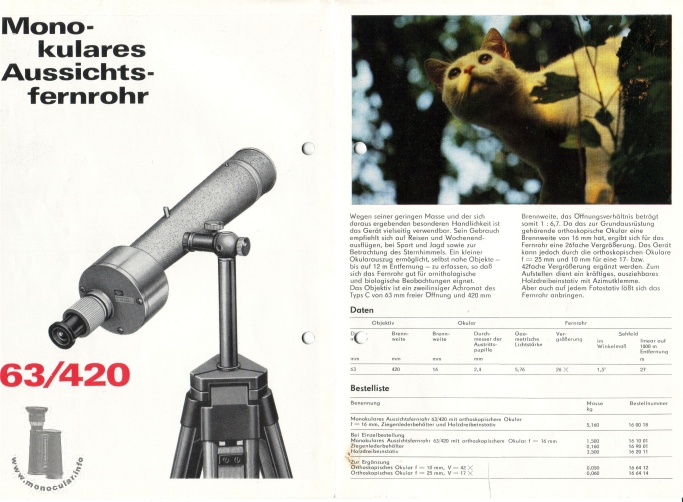
Fotos: 1-7, 10-16 Zeun; 8-9, 17-20 Ebay/Auktionen

